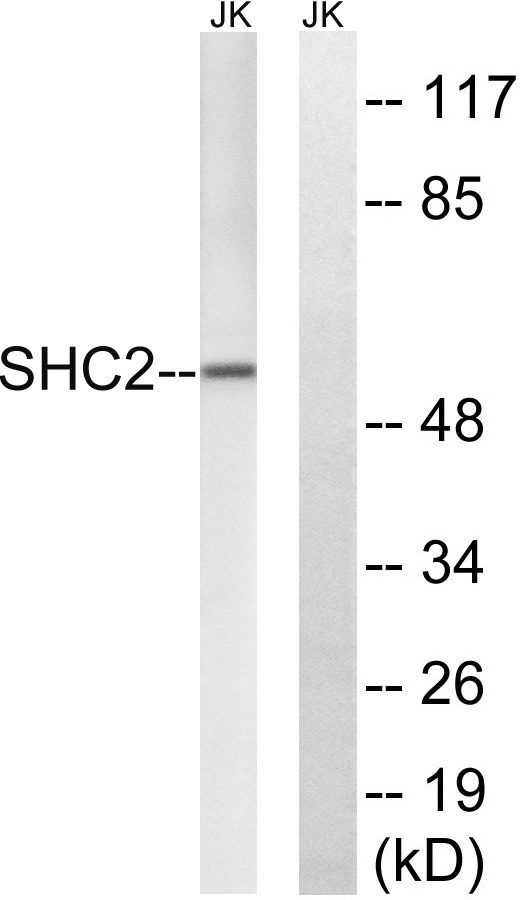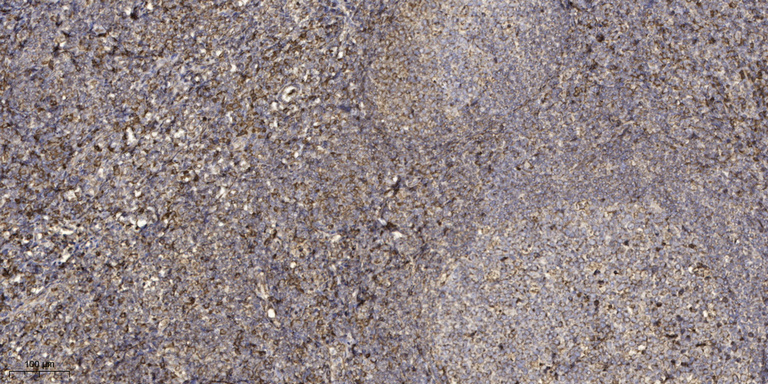Sck Polyclonal Antibody
- Catalog No.:YT4222
- Applications:WB;IHC
- Reactivity:Human;Rat
- Target:
- Sck
- Fields:
- >>EGFR tyrosine kinase inhibitor resistance;>>Endocrine resistance;>>ErbB signaling pathway;>>Ras signaling pathway;>>Chemokine signaling pathway;>>Phospholipase D signaling pathway;>>VEGF signaling pathway;>>Focal adhesion;>>Natural killer cell mediated cytotoxicity;>>Neurotrophin signaling pathway;>>Insulin signaling pathway;>>Estrogen signaling pathway;>>Prolactin signaling pathway;>>Relaxin signaling pathway;>>Growth hormone synthesis, secretion and action;>>Alcoholism;>>Bacterial invasion of epithelial cells;>>Glioma;>>Chronic myeloid leukemia;>>Breast cancer;>>Hepatocellular carcinoma;>>Gastric cancer
- Gene Name:
- SHC2
- Protein Name:
- SHC-transforming protein 2
- Human Gene Id:
- 25759
- Human Swiss Prot No:
- P98077
- Mouse Swiss Prot No:
- Q8BMC3
- Rat Gene Id:
- 314612
- Rat Swiss Prot No:
- O70142
- Immunogen:
- The antiserum was produced against synthesized peptide derived from human SHC2. AA range:261-310
- Specificity:
- Sck Polyclonal Antibody detects endogenous levels of Sck protein.
- Formulation:
- Liquid in PBS containing 50% glycerol, 0.5% BSA and 0.02% sodium azide.
- Source:
- Polyclonal, Rabbit,IgG
- Dilution:
- WB 1:500-2000;IHC 1:50-300
- Purification:
- The antibody was affinity-purified from rabbit antiserum by affinity-chromatography using epitope-specific immunogen.
- Concentration:
- 1 mg/ml
- Storage Stability:
- -15°C to -25°C/1 year(Do not lower than -25°C)
- Other Name:
- SHC2;SCK;SHCB;SHC-transforming protein 2;Protein Sck;SHC-transforming protein B;Src homology 2 domain-containing-transforming protein C2;SH2 domain protein C2
- Observed Band(KD):
- 59kD
- Background:
- domain:The PID domain mediates binding to the TrkA receptor.,function:Signaling adapter that couples activated growth factor receptors to signaling pathway in neurons. Involved in the signal transduction pathways of neurotrophin-activated Trk receptors in cortical neurons.,miscellaneous:PubMed:15057824 has shown that SHC2 is poorly phosphorylated by the Trk receptors, in opposite to PubMed:12006576.,PTM:Phosphorylated on tyrosines by the Trk receptors.,similarity:Contains 1 PID domain.,similarity:Contains 1 SH2 domain.,subunit:Interacts with the Trk receptors in a phosphotyrosine-dependent manner and MEGF12. Once activated, binds to GRB2.,tissue specificity:Expressed in brain. Expressed at high level in the hypothalamus and at low level in the caudate nucleus.,
- Function:
- domain:The PID domain mediates binding to the TrkA receptor.,function:Signaling adapter that couples activated growth factor receptors to signaling pathway in neurons. Involved in the signal transduction pathways of neurotrophin-activated Trk receptors in cortical neurons.,miscellaneous:PubMed:15057824 has shown that SHC2 is poorly phosphorylated by the Trk receptors, in opposite to PubMed:12006576.,PTM:Phosphorylated on tyrosines by the Trk receptors.,similarity:Contains 1 PID domain.,similarity:Contains 1 SH2 domain.,subunit:Interacts with the Trk receptors in a phosphotyrosine-dependent manner and MEGF12. Once activated, binds to GRB2.,tissue specificity:Expressed in brain. Expressed at high level in the hypothalamus and at low level in the caudate nucleus.,
- Subcellular Location:
- intracellular,cytosol,plasma membrane,
- Expression:
- Expressed in brain. Expressed at high level in the hypothalamus and at low level in the caudate nucleus.
- June 19-2018
- WESTERN IMMUNOBLOTTING PROTOCOL
- June 19-2018
- IMMUNOHISTOCHEMISTRY-PARAFFIN PROTOCOL
- June 19-2018
- IMMUNOFLUORESCENCE PROTOCOL
- September 08-2020
- FLOW-CYTOMEYRT-PROTOCOL
- May 20-2022
- Cell-Based ELISA│解您多样本WB检测之困扰
- July 13-2018
- CELL-BASED-ELISA-PROTOCOL-FOR-ACETYL-PROTEIN
- July 13-2018
- CELL-BASED-ELISA-PROTOCOL-FOR-PHOSPHO-PROTEIN
- July 13-2018
- Antibody-FAQs
- Products Images

- Western blot analysis of lysates from Jurkat cells, using SHC2 Antibody. The lane on the right is blocked with the synthesized peptide.

- Immunohistochemical analysis of paraffin-embedded human tonsil. 1, Antibody was diluted at 1:200(4° overnight). 2, Tris-EDTA,pH9.0 was used for antigen retrieval. 3,Secondary antibody was diluted at 1:200(room temperature, 45min).



